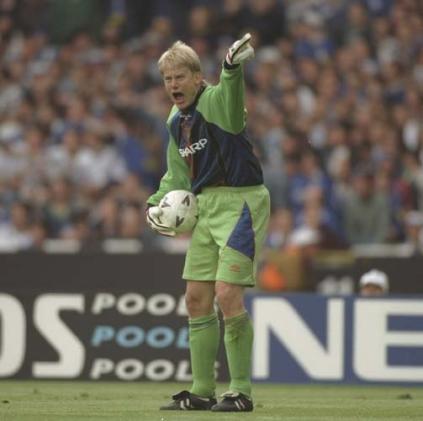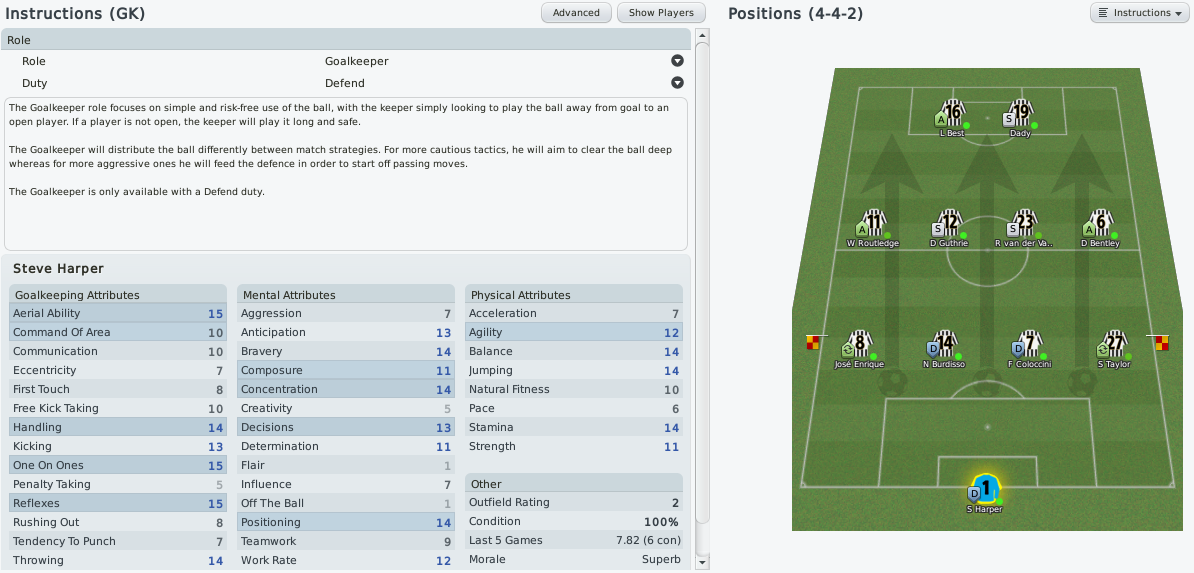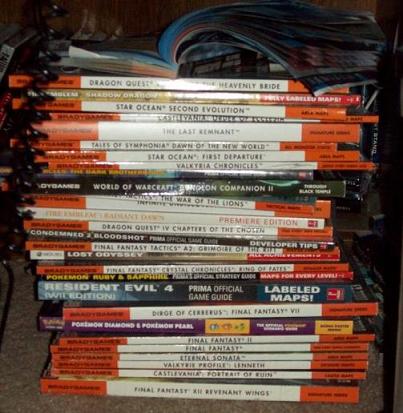-
Recent Articles
Building Your Defence: Full Backs
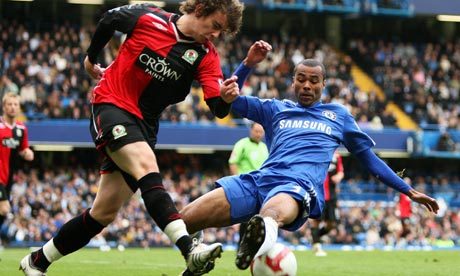 The modern full back is quickly becoming one of the most important players on the team sheet, infact even back in the days of Brian Clough, fat ed' argued that because of the space these players get in the final...
The modern full back is quickly becoming one of the most important players on the team sheet, infact even back in the days of Brian Clough, fat ed' argued that because of the space these players get in the final...False Nine Tactics
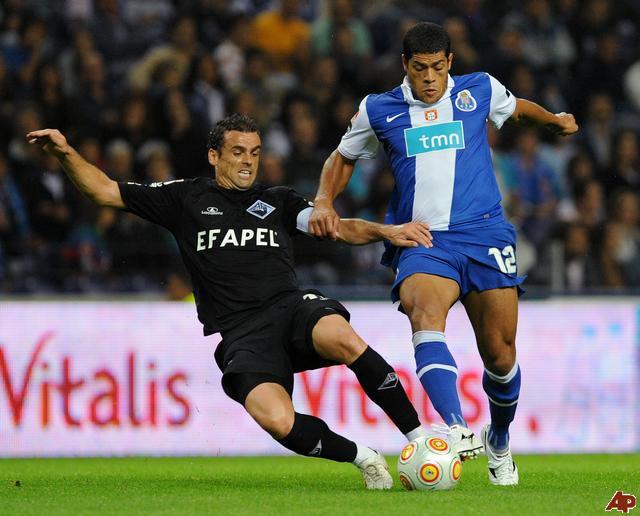 When we think about modern football trends, we think about the fall of the 4-4-2, the introduction of inverted wingers and the rise of the 4-5-1. But there is one other tactical rise that seems to have...
When we think about modern football trends, we think about the fall of the 4-4-2, the introduction of inverted wingers and the rise of the 4-5-1. But there is one other tactical rise that seems to have...An Open Letter To The Football Manager Community
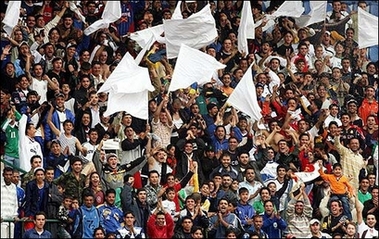 To view Sports Interactive's response, click here FM-Britain will no longer be producing regular content. Sports Interactive have objected to our content model of charging for annual strategy guides,...
To view Sports Interactive's response, click here FM-Britain will no longer be producing regular content. Sports Interactive have objected to our content model of charging for annual strategy guides,...How Will Jose Mourinho Manage at Real Madrid? (Part 7)
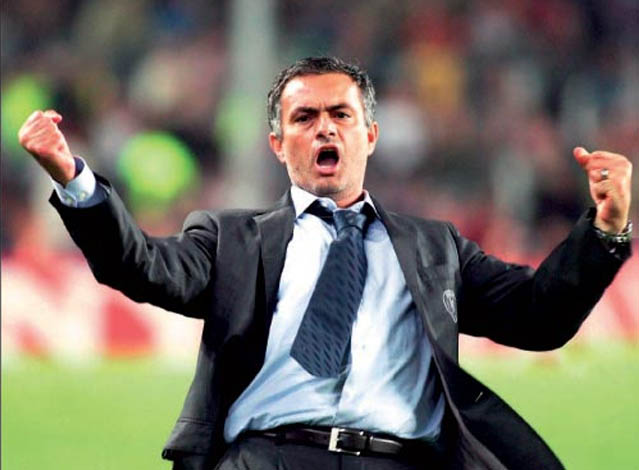 Last time around I showed you the gaping holes in my tactical plan. Against smaller teams, my players were not imposing themselves enough on the game, nor were they able to break through more disciplined...
Last time around I showed you the gaping holes in my tactical plan. Against smaller teams, my players were not imposing themselves enough on the game, nor were they able to break through more disciplined...From Giant to Underdog: Managing a Bulgarian Powerhouse (Part 3)
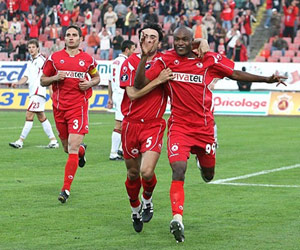 After setting the tactics for our team in the previous post, we'll look how they are going to play out in a game situation. Our first friendly will give us a chance to see how our players will handle the tactics. The...
After setting the tactics for our team in the previous post, we'll look how they are going to play out in a game situation. Our first friendly will give us a chance to see how our players will handle the tactics. The...
JOIN 10,227 READERS - SUBSCRIBE NOW TO OUR FOOTBALL MANAGER NEWSLETTER
Get the latest FM news & best community content delivered directly to your e-mail inbox!
How To Recreate Real Life Tactics in FM Using ESPN Soccernet
Written by: Gareth Millward
Category: Formations
Posted on: November 18, 2009
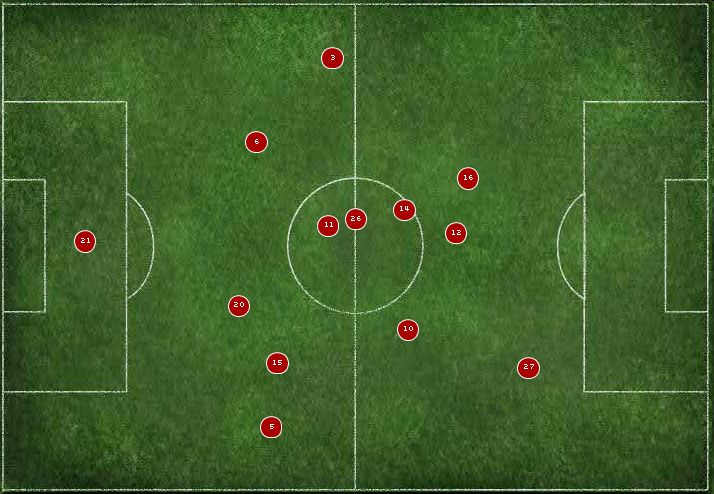
November 18, 2009
A lot of Football Manager players come onto the forums asking “how do I play like (insert team name here)”. And in a lot of cases, it’s difficult to tell. How do Juventus play? Or Ajax? Or Coventry? More importantly, how does the person asking the question think they play?
Most of the time, I admit to shrugging my shoulders. I don’t know, with certainty, how a particular side plays. But now, with the wonders of the internet, it is possible to get some ideas.
In the first of an occasional series, FM-Britain will look at some of these tools, and how they can help you in your attempts to recreate real-life styles.
Working out the formation
One of the things you’re likely to hear on the forums is “I want to play Ancelotti’s diamond”, or “I want to play the Arsenal 4-3-3”. Partly this is due to the common mistake of thinking “formation” means the same as “tactics”, but partly it’s because formation is probably the most basic and most obvious football concept. But what shape is Arsene Wenger’s 4-3-3? We’ve had enough debate about it on our forums! How can we even begin to answer this question (besides trading subjective opinions on certain matches)?
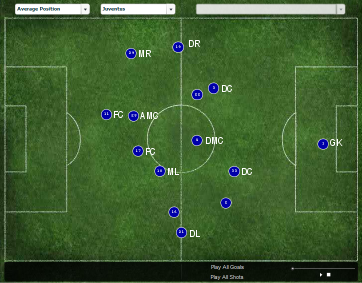
Voila! ESPN Soccernet’s “average position” charts. These diagrams take the positions where players touch the ball and then average them out to find the player’s mean position. As you can see, it gives a very good visual guide to the shape of the team, and where each player moves in relation to his team mates (the extra writing is by me, and notes the 11 starters and their position according to the match report).
On the down side, every player is thrown on to the chart, subs as well as starters. But by hovering the mouse over a particular player you can see who is who – and most importantly, you can check the team sheet to see who the starters were and judge what the starting formation was.
The above diagram is taken from a Juventus against Sienna match earlier this season. It shows that the team play a holding midfielder and that the full backs are able to push on beyond him down the wing. It also suggests that the striker is quite advanced and that the team use a lot of width, especially down the right wing. All of this information is very useful when deciding the Football Manager-equivalent formation.
Player roles
The above diagram also helps with player roles. Take, for instance, the nominally left-sided midfielder. According to the average position chart, he doesn’t push on very far, and indeed appears to play almost in the centre of the park. This would suggest that the full back is an attacking wing back and that the ML is probably a side midfielder (if not a MCl), possibly with a support duty. Of course, there are other interpretations – but we can be reasonably certain that, in this game at least, the winger is not bombing on forward, getting wide and deep into the opposition’s half.
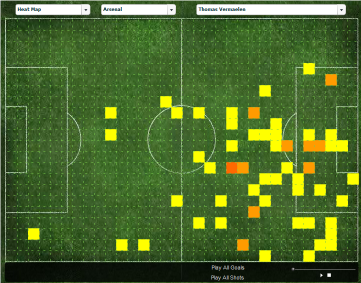
This is where the “heat map” comes in very handy. The lighter yellow blocks here represent a couple of touches of the ball for the player. The more dark orange they become, the more times the player touched the ball in that sector of the field. This is a heat map for Thomas Vermaelen in the West Ham versus Arsenal match.
We can tell by this that he is a defensive player, spending most of his time on the edge of his own area. We can tell also that he played on the left side of the centre of defence, more than likely as a DCl (the average position graph would help confirm this). Yet, we can also see that he is given licence to get forward. There are some darker orange squares near to the half way line in the centre and also towards the left touchline. He also got some touches of the ball well into the opposition’s half.
He is more than likely, then, a defender with some licence to get forward. A ball-playing defender perhaps? Or even a “libero”, encouraged to get forward (a role for the DC that, sadly, as yet the tactics creator does not simulate)?
So, with a combination of the heat map and the average position graph, we can take some educated guesses as to not only the starting position of the player (his place on the Football Manager tactics diagram), but also his movement from and behaviour within that position (his role and duty in the Football Manager tactics creator).
Style of play
What these tools cannot do, however, is impart their wisdom about the more aesthetic parts of football. Philosophy. Mentality. Style. Sure, we can discern certain things from the graphs – Juventus, for example, were clearly pulling wide, and willing (or able) to push forward quite often. We can take a guess, therefore, at how they really played. But short of watching their games with our own eyes, it is very difficult to translate the subjective world of football into the virtual world of the Football Manager match engine.
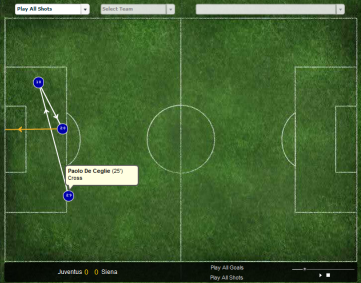
We do have some help., though. The ESPN Soccernet stats will replay certain key moments of the game from an attacking perspective. Noting the actions of the attackers, it will replay the moves that led to goal-scoring opportunities. Now, clearly this doesn’t help us re-model a team’s real-world defensive shape. But it can give us some clues as to how a team attacks – and if we can recreate some of the moves that occur in the statistics into our Football Manager saves, then we know we’re on the right track.
So, how useful is all this stuff?
Statistics are emotionless beasts. We cannot vouch for the total accuracy of them, nor do they convey any sense of style, or beauty. What they can do (if taken over a number of games to reduce error) is give a general picture of the shape and composition of a team. These basic building blocks of the tactic – formation, player roles and play duties – can be inferred from these diagrams. They may be static, and fail to give the full picture, but they are, nevertheless, rather useful for those basic questions we get asked (what is Arsene Wenger’s formation, is Robinho a winger or a striker, what exactly does Ronaldinho do for 90 minutes?).
As for ESPN Soccernet – how good is the service? Well, it has certain limitations. Although they hold the basic stats on a number of leagues around the globe (including Russia, the United States and many more), the actual diagrams only appear for the top European leagues. This is a bit of a shame – I’m becoming more and more interested in Eastern European football, and would love to get some stats from those leagues to see how they play. Similarly, lower league football becomes impossible to analyse this way because there simply aren’t the stats available.
However, for a rough guide on the leagues it does model properly, it’s a fantastic resource. Going back over a number of matches for Arsenal, I was able to prove myself wrong about my assumptions about Arsene Wenger’s 4-3-3. I had assumed (based on the games I had watched) that he played two MCs and an AMC. However, on closer reflection it seems that he only occasionally uses this setup, and ordinarily prefers a midfield with two MCs and a DMC.
Now, of course, all of this is absolutely no substitute for watching a match live and making observations about how players move, where they fit into a larger system and how they use the ball (in and out of possession). But for those who can’t watch hours and hours of TV footage or can’t afford a season ticket, this is certainly a good stop-gap. Using the information here is a starting point for debate, but obviously not the final word.
If you’ve found anything useful using this tool or any others on the internet, why not tell us about them? The Tactical Theorems Research Forum is full of people asking and answering questions about how teams play and how to recreate this in Football Manager. So, pop along and see what information is there and help correct some misconceptions. Everything’s open for debate, so long as we can help everyone emulate the styles they’re looking for!
About The Author: Gareth Millward
Member of the FM-B Think Tank and one of the main authors and editors of FM-B’s tactical guides and e-books, Millie organises the content for the main site. He has a particular interest in the history of football tactics (probably because in real life he is an historian) and in recreating real-world football in the FM match engine.
Download Our Tactical Theorems '10 eBook Absolutely Free

Presenting the most comprehensive tactic design and match strategy guide to the Football Manager series ever created!
Written by FM match engine beta testers, it's 60+ pages of easy-to-read concepts and ideologies for getting your team playing exactly how you want each match! It's been downloaded over 100,000+ times to date!
Find out more information about our tactical eBook
and download Tactical Theorems '10 right now!
Written by FM match engine beta testers, it's 60+ pages of easy-to-read concepts and ideologies for getting your team playing exactly how you want each match! It's been downloaded over 100,000+ times to date!
and download Tactical Theorems '10 right now!


